Murad I
Murad I (Ottoman Turkish: مراد اول; Turkish: I. Murad, Murad-ı Hüdavendigâr (nicknamed Hüdavendigâr, from Persian: خداوندگار, romanized: Khodāvandgār, lit. 'the devotee of God' – meaning "sovereign" in this context); 29 June 1326 – 15 June 1389) was the Ottoman Sultan from 1362 to 1389. He was a son of Orhan Gazi and Nilüfer Hatun. Murad I came into the throne after his elder brother Süleyman Pasha's death.
| Murad I | |||||
|---|---|---|---|---|---|
| |||||
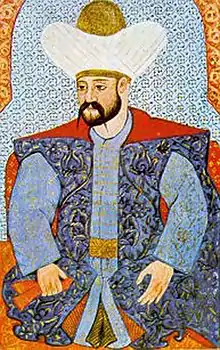 Miniature of Murad I from 16th-century manuscript | |||||
| 3rd Sultan of the Ottoman Empire (Padishah) | |||||
| Reign | March 1362 – 15 June 1389 | ||||
| Predecessor | Orhan | ||||
| Successor | Bayezid I | ||||
| Born | 29 June 1326 Bursa,[1][2] Ottoman Beylik | ||||
| Died | 15 June 1389 (aged 62) Kosovo field, District of Branković | ||||
| Burial | Organs buried at Tomb of Sultan Murad, Kosovo[lower-alpha 1] 42°42′07″N 21°06′15″E Other remains buried at Sultan Murad Türbe, Osmangazi, Bursa | ||||
| Spouses | Gülçiçek Hatun Thamara Hatun Paşa Melek Hatun | ||||
| Issue | See below | ||||
| |||||
| Ottoman Turkish | مراد اول | ||||
| Turkish | Murad-ı Hüdavendigâr | ||||
| Dynasty | Ottoman | ||||
| Father | Orhan | ||||
| Mother | Nilüfer Hatun | ||||
| Religion | Sunni Islam | ||||
| Tughra |  | ||||
Murad I conquered Adrianople, renamed it to Edirne,[2] and in 1363 made it the new capital of the Ottoman Sultanate.[3] Then he further expanded the Ottoman realm in Southern Europe by bringing most of the Balkans under Ottoman rule, and forced the princes of Serbia and Bulgaria as well as the East Roman emperor John V Palaiologos to pay him tribute.[2] Murad I administratively divided his sultanate into the two provinces of Anatolia (Asia Minor) and Rumelia (the Balkans).
Titles
According to the Ottoman sources, Murad I's titles included Bey, Emîr-i a’zam (Great Emir), Ghazi, Hüdavendigâr, Khan, Padishah, Sultânü’s-selâtîn (Sultan of sultans), Melikü’l-mülûk (Malik of maliks), while in Bulgarian and Serbian sources he was referred to as Tsar. In a Genoese document, he was referred to as dominus armiratorum Turchie (Master lord of Turks).[4]
Wars
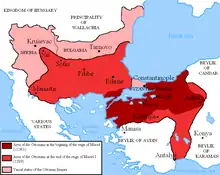
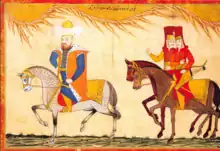
Murad fought against the powerful beylik of Karaman in Anatolia and against the Serbs, Albanians, Bulgarians and Hungarians in Europe. In particular, a Serb expedition to expel the Turks from Adrianople led by the Serbian brothers King Vukašin and Despot Uglješa, was defeated on September 26, 1371, by Murad's capable second lieutenant Lala Şâhin Paşa, the first governor (beylerbey) of Rumeli. In 1385, Sofia fell to the Ottomans. In 1386 Prince Lazar Hrebeljanović defeated an Ottoman force at the Battle of Pločnik. The Ottoman army suffered heavy casualties, and was unable to capture Niš on the way back.
Battle of Kosovo
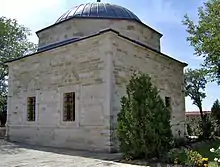
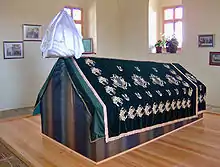
In 1389, Murad's army defeated the Serbian Army and its allies under the leadership of Lazar at the Battle of Kosovo. There are different accounts from different sources about when and how Murad I was assassinated. The contemporary sources mainly noted that the battle took place and that both Prince Lazar and the Sultan lost their lives in the battle. The existing evidence of the additional stories and speculations as to how Murad I died were disseminated and recorded in the 15th century and later, decades after the actual event. One Western source states that during the first hours of the battle, Murad I was assassinated by Serbian nobleman and knight Miloš Obilić by knife.[5][6] Most Ottoman chroniclers (including Dimitrie Cantemir)[7] state that he was assassinated after the finish of the battle while going around the battlefield. His older son Bayezid, who was in charge of the left wing of the Ottoman forces, took charge after that. His other son, Yakub Bey, who was in charge of the other wing, was called to the Sultan's command center tent by Bayezid, but when Yakub Bey arrived he was strangled, leaving Bayezid as the sole claimant to the throne.
In a letter from the Florentine senate (written by Coluccio Salutati) to the King Tvrtko I of Bosnia, dated 20 October 1389, Murad I's (and Jakub Bey's) killing was described. A party of twelve Serbian lords slashed their way through the Ottoman lines defending Murad I. One of them, allegedly Obilić, had managed to get through to the Sultan's tent and kill him with sword stabs to the throat and belly.[8]
Murad's internal organs were buried in Kosovo field and remain to this day on a corner of the battlefield in a location called Meshed-i Hudavendigar which has gained a religious significance for the local Muslims. It was vandalized between 1999–2006 and was renovated recently. His other remains were carried to Bursa, his Anatolian capital city, and were buried in a tomb at the complex built in his name.[9]
Establishment of sultanate
He established the sultanate by building up a society and government in the newly conquered city of Adrianople (Edirne in Turkish) and by expanding the realm in Europe, bringing most of the Balkans under Ottoman rule and forcing the Byzantine emperor to pay him tribute. It was Murad who established the former Osmanli tribe into an sultanate. He established the title of sultan in 1363 and the corps of the janissaries and the devşirme recruiting system. He also organised the government of the Divan, the system of timars and timar-holders (timariots) and the military judge, the kazasker. He also established the two provinces of Anadolu (Anatolia) and Rumeli (Europe).
Family
He was the son of Orhan and the Valide Hatun Nilüfer Hatun, daughter of the Lord of Yarhisar, who was of ethnic Greek descent.[10]
Wives
- Gülçiçek Hatun;
- Paşa Melek Hatun, daughter of Kızıl Murad Bey;
- In 1370 Thamara Hatun – daughter of Bulgarian Tsar Ivan Alexander;
Sons
- Yahşi Bey;
- Şehzade Savcı Bey – son. He and his ally, Byzantine emperor John V Palaeologus' son Andronicus,[11] rebelled against their fathers. Murad had Savcı killed. Andronicus, who had surrendered to his father, was imprisoned and partly blinded at Murad's insistence.[12]
- Sultan Bayezid I (1354–1402) – son of Gülçiçek Hatun;
- Şehzade Yakub Çelebi (? – d. 1389) – son. Bayezid I had Yakub killed during or following the Battle of Kosovo at which their father had been killed.
- Şehzade Ibrahim;
Daughter
- Nefise Hatun;
Further reading

- Harris, Jonathan, The End of Byzantium. New Haven and London: Yale University Press, 2010. ISBN 978-0-300-11786-8
- Imber, Colin (2009). The Ottoman Empire, 1300–1650: The Structure of Power (Second ed.). Basingstoke: Palgrave Macmillan. ISBN 978-1-1370-1406-1.
Notes and references
Notes:
- The political status of Kosovo is disputed. Having unilaterally declared independence from Serbia in 2008, Kosovo is formally recognised as an independent state by 100 UN member states (with another 13 states recognising it at some point but then withdrawing their recognition) and 93 states not recognizing it, while Serbia continues to claim it as part of its own sovereign territory.
References:
- "Murad I". www.theottomans.org.
- "Murad I". Encyclopædia Britannica Inc., 2014. Web. 19 Dec. 2014.
- "In 1363 the Ottoman capital moved from Bursa to Edirne, although Bursa retained its spiritual and economic importance." Ottoman Capital Bursa. Official website of Ministry of Culture and Tourism of the Republic of Turkey. Retrieved 19 December 2014.
- Halil İnalcık (2006). "Murad I". TDV Encyclopedia of Islam, Vol. 31 (Muhammedi̇yye – Münâzara) (in Turkish). Istanbul: Turkiye Diyanet Foundation, Centre for Islamic Studies. pp. 156–164. ISBN 978-975-389-458-6.
- Helmolt, Ferdinand. The World's History, p.293. W. Heinemann, 1907.
- Fine, John. The Late Medieval Balkans, p. 410. University of Michigan Press, 1994. ISBN 0-472-08260-4.
- Cantemir, Dimitrie, History of the Growth and Decay of the Osman Ottoman Empire, London 1734.
- Wayne S. Vucinich, Thomas A. Emmert (1991). Kosovo: Legacy of a Medieval Battle. University of Minnesota. ISBN 9789992287552.
- "Meşhed-i Hüdavendigar – www.sultanmurad.com" (in Turkish). Retrieved 2019-01-14.
- Lowry, Heath (2003). The Nature of the Early Ottoman State. Albany: SUNY Press. p. 153. ISBN 0-7914-5636-6.
- Gibbon, Edward, Decline and Fall of the Roman Empire, Modern Library, v. iii, p. 651
- Finkel, C., Osman's Dream: The History of the Ottoman Empire, 2005, p. 19, Basic Books
External links
![]() Media related to Murad I at Wikimedia Commons
Media related to Murad I at Wikimedia Commons
- . Encyclopædia Britannica. Vol. 19 (11th ed.). 1911. p. 14.
.svg.png.webp)